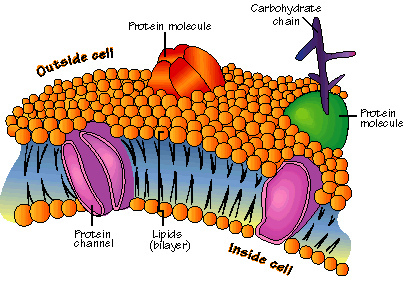9th Grade > Biology
THE FUNDAMENTAL UNIT OF LIFE MCQs
:
A and D
Plasma membrane is a selectively permeable membrane. It covers the cytoplasm. It is made up of a phospholipid bilayer with protein molecules embedded in it. It also consists of carbohydrates and water. The ratio of proteins to lipids varies in different membranes. 
:
B, C, and D
- Plant cells are characterised by the presence of a rigid cell wall made up of cellulose, whereas animal cells do not contain cell wall.
- Centrioles are barrel-shaped organelles found in the cells of animals and protists. They are involved in cell division. They are absent in higher plants such as gymnosperms and angiosperms.
- In plant cells only one large prominent vacuole is present. In animal cells on the other hand, vacuoles are smaller in size and more in number.
- Animal cells do not contain plastids like chloroplasts (which contains chlorophyll), chromoplasts (coloured plastids) and leucoplasts (colourless plastids).
:
B
In a cell which is not dividing, DNA is present as part of chromatin fibres/material. These are called chromatin because they get coloured when they are stained. This chromatin material is visible as an entangled mass of thread-like structures. Whenever the cell is about to divide, the chromatin material gets condensed and organised into chromosomes.
:
A
Leucoplasts are the non-pigmented organelles which are colorless. They are usually found in most of the non-photosynthetic parts of the plant like roots. They act as a storage shed for starches, lipids, and proteins depending on the needs of plant.
:
A
Cells modify themselves according to the function they perform. Therefore, different cells have different shapes. For example, nerve cells have long processes called axons, as they have to carry information to long distances.
:
B
Plasma membrane is an external covering of the cell. It separates the contents of the cell from the external surroundings. Since, it allows the entry and exit of only certain substances (e.g., molecules, ions, etc.) it is known as a selectively permeable membrane.
:
B
The fundamental unit of life - cell, exhibits a fine division of labour within itself. Cellular organelles are designated to perform specific functions responsible for the normal metabolism of the cell, such as making new material in the cell, clearing up the waste material from the cell and so on.
:
C
The organelle depicted in the given image is a mitochondrion. It is a double-membraned organelle with its own genetic material. Since it is involved in the production of energy-rich ATP (Adenosine triphopshate), it is also known as the "powerhouse of the cell".
:
C and D
- Vacuoles are single-membrane bound, fluid filled spaces. They are present in the cytoplasm of the cell.
- Vacuoles are present in both plant and animal cell. In animal cells they are smaller in size and lesser in number.
- Plant cells on the other hand have one large vacuole which may occupy 50-90% of the cell volume.
- In amoeba, the food vacuole contains the food items which the organism consumes. In some unicellular organisms, specialised vacuoles also play important role in expelling excess water and some wastes from the cell.
:
C
In the year 1665, Robert Hooke observed cork cells under the microscope. Hooke saw cell walls in cork tissue and coined the term 'cells' for them, as the box-like compartments of cork reminded him of the cells of a monastery. Cell is a Latin word for ‘a little room’.

















